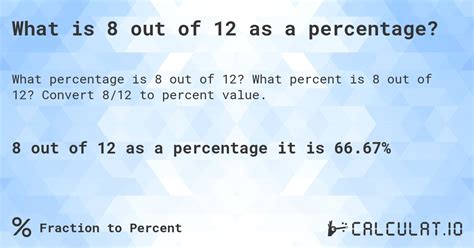What Is 8 12 As A Percent
Kalali
Apr 03, 2025 · 4 min read

Table of Contents
What is 8/12 as a Percent? A Comprehensive Guide to Fraction-to-Percentage Conversions
Understanding how to convert fractions to percentages is a fundamental skill in mathematics with wide-ranging applications in everyday life, from calculating discounts and tips to analyzing data and understanding financial statements. This comprehensive guide will walk you through the process of converting the fraction 8/12 into a percentage, exploring various methods and providing valuable insights into the underlying concepts. We'll also delve into practical applications and offer tips for mastering fraction-to-percentage conversions.
Understanding Fractions and Percentages
Before we dive into the conversion of 8/12, let's establish a clear understanding of fractions and percentages.
Fractions: A fraction represents a part of a whole. It's expressed as a ratio of two numbers: the numerator (the top number) and the denominator (the bottom number). The numerator indicates the number of parts we have, while the denominator indicates the total number of parts in the whole.
Percentages: A percentage is a way of expressing a number as a fraction of 100. The symbol "%" is used to denote a percentage. Essentially, a percentage shows the proportion of a whole as a specific number out of 100.
Method 1: Simplifying the Fraction Before Conversion
The fraction 8/12 can be simplified before converting it to a percentage. Simplification makes the calculation easier and often results in a more manageable percentage.
Simplifying 8/12:
Both the numerator (8) and the denominator (12) are divisible by 4. Dividing both by 4, we get:
8 ÷ 4 = 2 12 ÷ 4 = 3
Therefore, 8/12 simplifies to 2/3.
Converting 2/3 to a Percentage:
To convert a fraction to a percentage, we divide the numerator by the denominator and then multiply the result by 100.
2 ÷ 3 ≈ 0.6667
0.6667 x 100 = 66.67%
Therefore, 8/12, simplified to 2/3, is approximately 66.67%. The recurring decimal in 0.6667 indicates that the percentage is actually 66.666...% For practical purposes, we round it to two decimal places.
Method 2: Direct Conversion Without Simplification
While simplifying is often recommended, you can also convert 8/12 directly to a percentage without simplifying first.
Converting 8/12 Directly:
Divide the numerator (8) by the denominator (12) and multiply by 100:
8 ÷ 12 ≈ 0.6667
0.6667 x 100 = 66.67%
As you can see, we arrive at the same result: approximately 66.67%. This method demonstrates that simplification, while helpful, isn't strictly necessary for the conversion.
Understanding the Significance of Recurring Decimals
The conversion of 2/3 (and therefore 8/12) results in a recurring decimal (0.666...). This is a characteristic of fractions where the denominator has prime factors other than 2 and 5. Recurring decimals highlight that some fractions cannot be expressed exactly as a finite decimal percentage. In practical applications, rounding is necessary to achieve a usable percentage value.
Practical Applications of Fraction-to-Percentage Conversions
The ability to convert fractions to percentages is essential in various real-world situations:
-
Calculating Discounts: If a store offers a discount of 8/12 on an item, you can quickly determine that it's a 66.67% discount.
-
Analyzing Test Scores: If you answered 8 out of 12 questions correctly on a test, your score is 66.67%.
-
Understanding Financial Statements: Financial reports often use fractions and percentages to represent financial ratios and performance metrics.
-
Data Analysis: Percentages provide an easy-to-understand way to present and interpret data from surveys, polls, and experiments.
-
Cooking and Baking: Recipe adjustments often involve fraction-to-percentage conversions to scale up or down ingredient quantities.
Advanced Techniques for Fraction-to-Percentage Conversions
For more complex fractions or when dealing with a large number of conversions, consider these techniques:
-
Using a Calculator: Most calculators have built-in functions to perform fraction-to-percentage conversions directly.
-
Using Spreadsheet Software: Spreadsheet programs like Microsoft Excel or Google Sheets offer functions for easily converting fractions to percentages. For example, Excel's
=A1*100%(where A1 contains the fraction) will directly give you the percentage. -
Online Converters: Numerous websites offer online fraction-to-percentage converters, eliminating manual calculations entirely.
Tips for Mastering Fraction-to-Percentage Conversions
-
Practice Regularly: Consistent practice is key to mastering any mathematical skill. Start with simple fractions and gradually increase the complexity.
-
Understand the Underlying Concepts: A strong grasp of fractions, decimals, and the concept of percentages is crucial for accurate and efficient conversions.
-
Utilize Different Methods: Explore both simplification and direct conversion methods to find the approach that best suits your understanding and the given fraction.
-
Check Your Work: Always double-check your calculations to ensure accuracy.
-
Use Visual Aids: Diagrams and charts can be helpful in visualizing fractions and percentages, especially when dealing with more complex scenarios.
Conclusion: Mastering the Art of Fraction-to-Percentage Conversion
Converting fractions to percentages is a fundamental skill applicable across many areas of life. By understanding the different methods, practicing regularly, and utilizing available tools, you can confidently and accurately convert fractions such as 8/12 to their percentage equivalent (approximately 66.67%). This knowledge empowers you to better analyze data, understand financial reports, and solve everyday problems involving proportions and ratios. Remember to always pay attention to recurring decimals and round appropriately for practical applications.
Latest Posts
Latest Posts
-
What Percent Of 1000 Is 2
Apr 03, 2025
-
How Many Oz Is In 1 3 Cup
Apr 03, 2025
-
How Many Ounces Is 3 5 Cups
Apr 03, 2025
-
How Long It Takes For Water To Boil
Apr 03, 2025
-
How Many Cups Is 500 Ml Of Water
Apr 03, 2025
Related Post
Thank you for visiting our website which covers about What Is 8 12 As A Percent . We hope the information provided has been useful to you. Feel free to contact us if you have any questions or need further assistance. See you next time and don't miss to bookmark.
